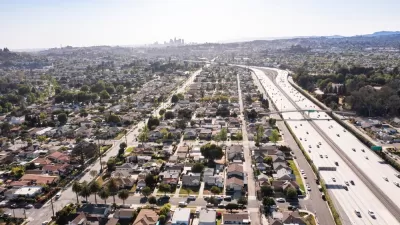With the help of housing experts, San Francisco Chronicle columnist Chip Johnson points to abuse of the California Environmental Quality Act by NIMBYs as one of the main reasons for the Bay Area's housing crisis. Ethan Elkind offers an opposing view.
"The spirit behind the state’s environmental law is sound, but its application in all manner of building proposals is not, experts say," writes Chip Johnson. CEQA, in the hands of NIMBYs (not-in-my-back-yard) becomes a powerful tool "to challenge, block, delay or kill construction projects across the state," he argues.
“It (CEQA) has been abused in this state for 30 years by people who use it when it has nothing to do with an environmental reason,” said Carol Galante, faculty director of the Terner Center for Housing Innovation at UC Berkeley, and a former assistant secretary of the U.S. Department of Housing and Urban Development.
“NIMBY-ism is connected to the fact that for everyone who owns their little piece of the dream, there’s no reason to want development next door to them,” she said.
“CEQA gives them a tool to effectuate their interest,” she said. “It’s a sense of entitlement that comes with an incentive, because it makes their property worth more money.'
"That’s downright disgusting," asserts Johnson. "It’s an entitlement fueled more by greed and selfishness than any legitimate environmental claim."
Ethan Elkind, an attorney who researches and writes on environmental law for the Center for Law, Energy and the Environment at the UC Berkeley School of Law, doesn't object to casting blame on NIMBYs, but he writes that Johnson "goes awry in singling out the California Environmental Quality Act (CEQA) as the primary culprit."
He cites the discredited Holland & Knight CEQA study as proving that infill projects suffer the most under CEQA, when that study defined the term so broadly that almost 90 percent of housing projects in the state are classified as “infill.” I wish he and others in the media would study up on this study before citing it, as it should not be used to inform policy going forward.
Discredited or not, Planetizen lists eight posts that reference the Holland & Knight law firm, including two on their CEQA study and two based on Curbed LA articles written by James Brasuell before he became Planetizen managing editor.
Elkind is no stranger to defending CEQA from charges that its misuse is the main reason preventing responsible infill, as a September 2012 post indicates. "[W]hen it comes to the big factors stopping infill, at least in California, CEQA ranks below a host of other barriers [PDF], such as local zoning codes that outlaw infill, lack of infrastructure investment, high construction costs, tax incentives that favor strip malls over housing, and poor neighborhood schools," he wrote in LegalPlanet. [More posts referencing Elkind here.]
Nonetheless, Elkind is in agreement with Johnson on four "possible remedies" offered by the Holland & Knight study, including:
- "requiring anyone filing a new lawsuit under CEQA to state their environmental concerns,
- "eliminating duplicate lawsuits for plans and projects that have already won approval."
Notwithstanding Elkind's warning to avoid making CEQA abuse the scapegoat for California's housing woes, Johnson concludes his column by making a strong case for CEQA reform, backed-up by Gallante:
If the Bay Area’s housing crunch is a byproduct of overzealous use of environmental law fueled by no-growth supporters, it’s the responsibility of the local and state elected officials to change that, even if means adopting measures to rein in state environmental laws, which were passed to preserve our environment, not bar the door to all new growth.
“We need to fundamentally rethink how the CEQA process works in this state,” Galante said. “I’m an academic. I say it like I see it, and this is a major issue that needs to be tackled.”
As readers no doubt know, It won't be easy.
Hat tip to Ethan Elkind, via LA Metro Transportation Research Library
FULL STORY: Bay Area Housing crisis fueled by greed, study finds

Maui's Vacation Rental Debate Turns Ugly
Verbal attacks, misinformation campaigns and fistfights plague a high-stakes debate to convert thousands of vacation rentals into long-term housing.

Planetizen Federal Action Tracker
A weekly monitor of how Trump’s orders and actions are impacting planners and planning in America.

In Urban Planning, AI Prompting Could be the New Design Thinking
Creativity has long been key to great urban design. What if we see AI as our new creative partner?

King County Supportive Housing Program Offers Hope for Unhoused Residents
The county is taking a ‘Housing First’ approach that prioritizes getting people into housing, then offering wraparound supportive services.

Researchers Use AI to Get Clearer Picture of US Housing
Analysts are using artificial intelligence to supercharge their research by allowing them to comb through data faster. Though these AI tools can be error prone, they save time and housing researchers are optimistic about the future.

Making Shared Micromobility More Inclusive
Cities and shared mobility system operators can do more to include people with disabilities in planning and operations, per a new report.
Urban Design for Planners 1: Software Tools
This six-course series explores essential urban design concepts using open source software and equips planners with the tools they need to participate fully in the urban design process.
Planning for Universal Design
Learn the tools for implementing Universal Design in planning regulations.
planning NEXT
Appalachian Highlands Housing Partners
Mpact (founded as Rail~Volution)
City of Camden Redevelopment Agency
City of Astoria
City of Portland
City of Laramie





























